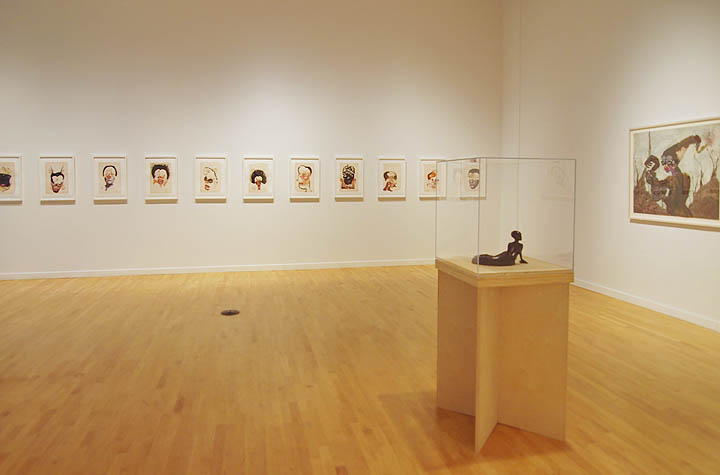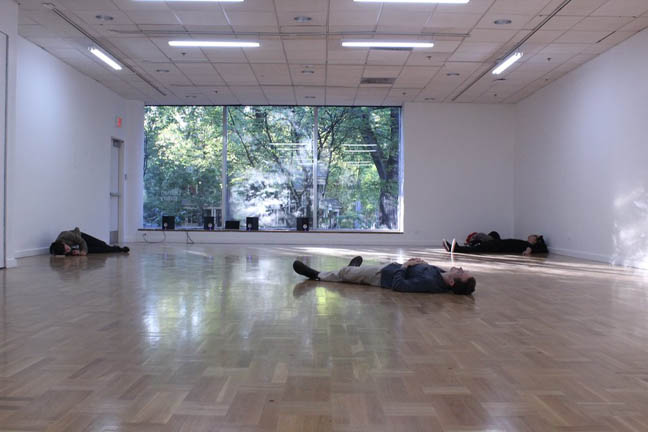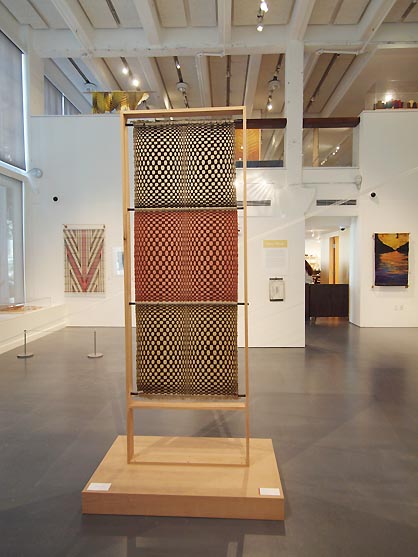
|
||
|
Portland art blog + news + exhibition reviews + galleries + contemporary northwest art
|
||
Saying goodby to 2016 As a year end exercise let's look at PORT's most read posts of 2016. It says a lot about Portland and the international audience that PORT reaches.
[About PORT] Recently I was reminded that PORT needs to remind people how and why we do what we do because PORT is innovative (forgive us if Ive repeated this but not everyone knows this spiel). Standard stuff, PORT reaches an enormous # of readers each year (over 1.5 million unique ones annually) and with 2016 being so tumultuous our readers turned to us to give the context that our depth, experience and prescience offers. Stylistically we purposefully avoid being an uninvolved observer (the province of the rapidly dying world of journalism) and instead adhere to the sense of being an on site historical observer and interlocutor (ala Herodotus, Baudelaire and a lot of art criticism out of London over the past 25 years). This gives us an more intimate expertise/edge with our subject matter and is related more to history than mere reportage. Instead, we act as a place where critical positions are shared (this will sometimes irk those who dont like to discuss things openly, but its the best way in a cultural scene still so young). Our style is to make our involvement in the subjects we cover clear, without the objective to sway anyone, but rather to make positions (including the ones we do not share) demystified and familiarized in depth. There can be a comprehensiveness and fairness that comes from being involved, more experienced and honorable. Basically, we care and we let our readers know why and how in detail. One of the tenants all our writers share is being intellectually driven rather than careerist as a reason to write about art, which is a huge problem with a lot of academic art discourse. It is my belief that true understanding doesn't come through consensus but rather through being intellectually curious about the perceptually divergent mechanisms that inform dissent and consent. PORT thanks our readers and sponsors who make this effort possible. [End wonky digression] That said, here are our 13 most read posts of 2016. In no particular order, these articles collectively paint a very interesting picture of Portland's art scene in 2016. I'll publish a more probing review as 2017 begins (yes things like institutional shifts at the Japanese Garden, PNCA, Portland Building, PICA, S1, James Beard Public Market and the Portland Art Museum etc. will get the space they deserve) ... till then chew on these:  Installation view: The Human Hybrid at PNCA's 511 Gallery (from the Collection of Jordan D. Schnitzer's Family Foundation) 2016 Was definitely a year for the ladies and Victor Maldonado's interview with Wangechi Mutu was insightful. We did a lot of prep for this, bringing in anthropological subjects and in particular I felt that Victor and Wangechi would have intersecting experiences as foreigners from syncretic cultures who attended elite art schools in the USA. The exercise did not disappoint.  Littman Gallery, PSU. 9/9/2016 for Ben Glas' Inging (Variation3) In a year full of tumult, PORT helped spearhead the groundswell of support that successfully saved the Littman Gallery at Portland State University. The PSU students were organized and invested... ultimately making the case for how art galleries break through the dreaded University Bubble. Will the U of O show similar insight into the value of a public art gallery or is it just a budgetary allocation exercise? Portland requires experimental spaces that are both inspiring and open to new ideas, perhaps no gallery in Portland has been so diverse a program. As a student run space it consistently puts most of the curatorial programs at other Universities in Portland to shame. One earns that and it taken 3 decades of engaged stewardship that doesnt take itself for granted to make that happen.  Mary Henry, The Fabric of Space at Jeffrey Thomas Fine Art Despite the election result 2016 was the year that women really took a spotlight. Two concordant exhibitions by Northwest luminaries Mary Henry and Bonnie Bronson showed some of the depth and excellence in a history where the contribution of women in mid Twentieth Century art is not well understood. If you missed the drawing survey we reviewed in April the Archer Gallery currently has a wonderful exhibition of Mary Henry's integration of the Bauhaus ideas suffused with West Coast sensibilities.  It is a fact, every artist who received a full critical review from PORT in 2016 was a woman but Diane Jacob's rumination on the ancient Amazon culture that rivaled that of the Greeks revealed another theme. That of technology and anthropology being central to art that doesn't merely entertain but enlightens through deeper ties and cultural threads. Jacobs Homage wasn't some academic book report but a way to make what we dont know more apparent. The traffic this review received internationally indicates that the artist touched a chord.  MoCC Exhibition view: Laurie Herrick Weaving, Yesterday, Today and Tomorrow (2011) Photo Jeff Jahn Portland also received a lot of bad news, the worst being the closure of the Museum of Contemporary Craft. PORT dispensed needed tough love as the program fell short in several ways... namely "Craft" cannot exist as a reaction to design. Craft is not simply something limited to hand made or over-fetished overt traces of effort (computer code is a kind of craft and is so similar to weaving). There is a place for the fetish of handiwork but by excluding new directions all the while consistently overhanging the exhibitions had a net effect of driving away the design professionals that appreciate craft. Notably the Oregon College of Art and Craft has a major new technology initiative, which received funding last year. There is legitimate anger over the closure by PNCA, which I'll discuss in my longer piece as 2017 begins (main point, if you dislike what happened find a way to buy the collection from PNCA and right size a new institution).  OCAC 2016 BFA graduate exhibition OCAC's BFA thesis exhibition generated a huge amount of interest to a simple weekend picks post. It was one of the best looking BFA shows I've ever seen. 
Mark Rothko retrospective at the Portland Art Museum 2012 (photo Jeff Jahn) News that the new expansion at the Portland Art Museum will be the Rothko Pavilion was not only welcome, it was a a vindication for PORT's constant hammering on the subject. In fact, it was confirmed that it was my "knight's move" Rothko Bridge idea that lead to the gift and plan. Only the short sighted think internet-based art criticism has no effect. Now can PAM execute in a way that lives up to the expectations Rothko's work creates? I'll get into that in my longer piece in 2017 but overall most museums are having a hard time as Gen X and Millennials increasingly feel disassociated towards them. I know how to fix this but as an "industry" museums dont want to hear what some critics like Jerry Saltz and I are telling them. MoMA and the Met both have huge problems and it comes down to curators as much as it does buildings. Art presenting institutions need to up their game in general, especially in Portland. PAM has made some moves but are they enough? Rothko will push them, he is one of the patron saints of pushing!  Andy Warhol Prints from the Collections of Jordan D. Schnitzer and His Family Foundation at the Portland Art Museum (photo Jeff Jahn) Speaking of saints, the Andy Warhol retrospective at PAM was a highlight of 2016 as was our interview with scholar Richard Axom on the occasion. The exhibition is the largest ever Warhol retrospective and focuses on his prints. The upstairs of the exhibition is a triumph, though the second downstairs portion gets a little lost in its sea of faces. That happens when you have so many portraits and a design firm like Ziba doing exhibition layout. Dont get me wrong, it is competent but perhaps overwhelmed/overwhelming. Perhaps a better solution would have cross between a Ruthenian Rite Catholic Church style Iconostasis (like Warhol grew up with) with the outright commerce of a store (tshirts, later album covers etc in the center) would have brought things more full circle. Warhol really is a time capsule, he brought what was prevalent in the media at the moment and turned it into a secular kind of iconography. That said, Warhol wasnt all faces, and I wish they had ended the show with an outro pairing of the sunsets and endangered species series juxtaposed so viewers would leave the exhibition with a late Warhol surprise? That said, you gotta love the way Howdy Doody and a skull print are next to one another downstairs. The show is absolutely worth multiple visits and it ends when the museum closes 5:00PM January 1st 2017. I've seen it 4 times, if you havn't yet this weekend is your last chance.  Works from Habitats, an exhibition in conjunction with the What is Media? Conference at the U of O Portland (photos Jeff Jahn) Another post that received a huge amount of international and local attention was for Habitats co-curated by conference co-director Jeremy Swartz, White Box curator Cris Moss and myself. PORT sponsored the exhibition (as did the the United Nations UNESCO fund) and featured pioneering artificial intelligence/feminist artist Lynn Hershman Leeson. As an exploration of media as a "habitat" rather than a genre it was perhaps the most multimedia exhibition Portland has ever seen with; Ai, drone based surveillance, 2 different virtual reality pieces, Kaityn Jenner's skull 3d printed and melted with bismuth, prospective animal/human hybrid organs, spatial mood engineering, social media carbon footprint monitoring, a digital honey bee hive, a ghostly slain wolfpack leader, a giant styrofoam robot made of of refuse and even printmaking + a stained glass shopping cart exploded the notion of medium and media. Huge thanks to all of the 16 artists: Anne Blackburn, Modou Dieng, Laura Fritz, Damien Gilley, Agatha Haines, David Heskin, Lindy Kehoe, Wade Larsen, Lynn Hershman Leeson, Brenna Murphy, Tabitha Nikolai, John Park and Jon Bellona, Portland Immersive Media Group, Michael Salter, Crystal Schenk and Adam Simmons. It was wonderful working with Jeremy and Cris as a triple threat team to pull together something completely unlike most group shows in Portland (treating traditional and new media the same as well as being both very international and local at the same time). I think it showed what could and should be happening more often at an institutional/curatorial level here. 
Lynn Hershman Leeson's Agent Ruby at the University of Oregon's White Box as part of Habitats, she's consistently listed as one of the pioneering female artists everyone should be aware of historically All of which is a good pivot to the terrible news that the University of Oregon plans to close the White Box gallery as part of its Portland campus. It effectively guts the Eugene based institution's community outreach in Portland and creates a lot of bad blood by treating its curator Cris Moss this way... he hasn't even been there 2 years and left the then excellent Linfield College Gallery to do so. Many of the artists and curators I know dont feel very interested in doing critiques and partnering with the U of O much after this short sighted news. They should reconsider because that gallery is the only thing that truly connects the school to Portland's art scene in a formal and substantial way. Send the Dean of AA&A a piece of your mind here.  Don Tuski PNCA's new President (Photo Mike Weymouth) Just one of the stories we broke locally, PNCA now has a new President, Don Tuski. He took the helm with a lot of labor strife at the college which was rocked by the dissolution of the Museum of Contemporary Craft and disputes with faculty. This was inevitable as PNCA had constantly expanded by adding new programs rather than double down on their strengths under Tom Manley. The art education market is now saturated in Portland so something had to give. I've met with Tuski and he's very aware that higher education has some terrible systematic problems regarding faculty pay. Can PNCA fix an industry-wide problem? It will be difficult but how PNCA addresses questions of quality in programs and people will say a lot about Portland in the years to come.  An installed view of Open This End at the Hoffman Gallery (L to R) Jack Pierson, Andy Warhol, Agnes Martin, Tony Smith and Rita Mcbride One of the best group shows in a year of rather unremarkable ones was Open This End at Lewis and Clark College. Drawn from the collection of one-time Portlander, Blake Byrne, our interview was almost as intellectually and life affirmingly stimulating as visiting the exhibition was.  Jasper Johns, White Flag (1955) Last but not least was my short essay on the surprise victory of Donald Trump over Hilary Clinton and what it could mean for art. It was one of the first articles on the subject on the internet and discussed the problem with smug liberal thinking that had alienated parts of the one time democratic base. There was an increasingly annoying tone from the art world over the past few years, a kind of drive for consensus in language and ideals (found everywhere at art schools) that left more progressive thinkers and the working class disenfranchised. In other words there was a middling liberal mendacity that acted like thought police that expected everyone to walk lock step. This made the art feel closed and arch academic/predictable (full of pre-approved language) rather than intellectual, open and unpredictable. Let's fix that and make Art a way of breaking down constraints not building them up. Posted by Jeff Jahn on December 31, 2016 at 10:44 | Comments (0) Comments Post a comment Thanks for signing in, . Now you can comment. (sign out)
(If you haven't left a comment here before, you may need to be approved by
the site owner before your comment will appear. Until then, it won't appear
on the entry. Thanks for waiting.)
|
| s p o n s o r s |
 |
 |
 |
 |
 |
 |
 |
 |
 |
 |
 |
 |
 |
 |

|
Site Design: Jennifer Armbrust | • | Site Development: Philippe Blanc & Katherine Bovee | |

